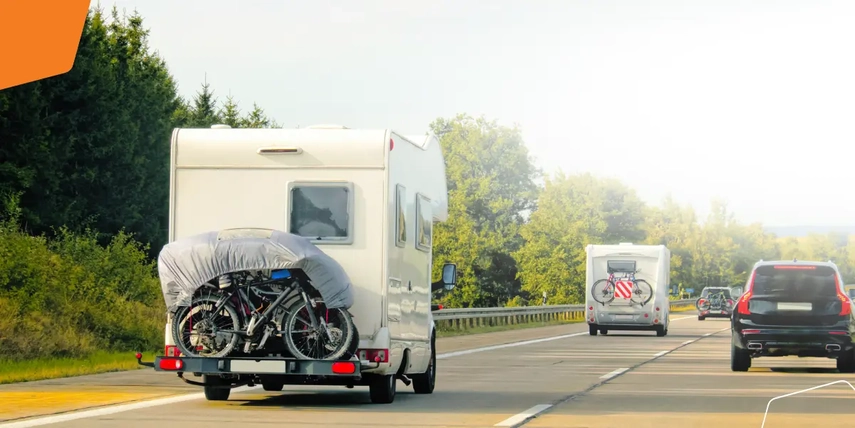Traveling by motorhome in Hungary: useful information before your trip
2025. 06. 23. 14:14
During the summer months, more and more international visitors choose to travel in Hungary by motorhome, as this form of travel not only offers a close-to-nature experience but also provides flexibility and independence. Traveling by motorhome is especially popular among those who want to plan their own route, prefer not to book accommodation, and enjoy discovering new places every day.
However, before setting out in Hungary, it's important to be aware of the rules and requirements related to motorhome travel—especially regarding highway usage fees.
Table of contents
- What kind of highway vignette is required for motorhomes?
- Motorhome or caravan – what's the difference?
- Holidaying in a motorhome
- Buying a highway vignette online, easily
- Summary
- FAQ
What kind of highway vignette is required for motorhomes?
The type of road usage authorization needed primarily depends on two factors: the category listed on the vehicle registration document and the vehicle’s maximum permissible total weight. To choose the correct vignette category, we recommend using our vehicle category assistant.
Motorhomes under 3.5 tons
Most privately used motorhomes fall into this category.
- If the "J" field of the vehicle registration states M1 or M1G, the vehicle is classified as a passenger vehicle.
- If the motorhome has a maximum permissible total weight of up to 3.5 tons and is suitable for transporting up to 7 people, a D1 category vignette must be purchased.
- If the vehicle can transport 8–9 people and is still classified as M1 or M1G, a D2 category vignette is required.
Motorhomes in the N1 or N1G category
These are typically vehicles originally manufactured as commercial vehicles and later converted into motorhomes.
If the total weight does not exceed 3.5 tons and it is suitable for transporting up to 9 people, a D2 category vignette is necessary.
Motorhomes over 3.5 tons
Motorhomes exceeding 3.5 tons do not fall under the highway vignette system but are subject to the HU-GO electronic toll payment system. In this case, tolls are calculated based on the road section used, the number of axles, and the maximum permissible total weight.
It is important to note that usage under the HU-GO system is not automatic: the vehicle must be registered in advance, and a route ticket must be purchased for each toll section. The system also allows for route planning and toll calculation, which is especially useful for longer trips or cross-country journeys.
What if you are towing a trailer?
When traveling by motorhome, it is common to tow a trailer—such as a bike carrier or caravan. Whether a separate vignette is required for the trailer depends on the category of the towing vehicle.
- If the towing vehicle falls under category D2, a separate U category vignette must be purchased for the trailer.
- If the towing vehicle falls under category D1, no separate vignette is required for the trailer.
Motorhome or caravan – what’s the difference
Although these terms are often used interchangeably in everyday language, there are important distinctions between motorhomes and caravans under regulation.
| Motorhome | Caravan | |
|---|---|---|
| Propulsion | Has its own engine, self-propelled | Not motorized, must be towed |
| Legal classification | Independent vehicle | Classified as a trailer in the registration |
Vignette type | Determined by the vehicle’s category | Determined by the towing vehicle’s category |
| Separate vignette? | Yes, always required | Only if the towing vehicle is D2 – U vignette needed |
Important:
- A caravan never requires a separate vignette if the towing vehicle is category D1.
- However, if the towing vehicle is category D2, a separate U category vignette is required for the caravan.
Holidaying in a motorhome
Hungary offers a diverse range of landscapes that are ideal for exploring by motorhome: Lake Balaton, Lake Tisza, and the mountain ranges of Mátra and Bükk are especially popular among foreign motorhome travelers.
Benefits of motorhome travel:
- Flexibility – You can stop anywhere permitted by regulations.
- Cost-efficiency – Considerable savings on accommodation during longer trips.
- Close-to-nature experience – Many campsites and rest areas offer infrastructure for motorhomes (electricity, water, sewage disposal).
Important to know: In Hungary, overnight stays in motorhomes are only allowed at designated places. Parking on public land for the purpose of sleeping is prohibited and may result in fines.
What to check before departure
- Check the category and total weight listed in the vehicle’s registration document.
- Purchase the appropriate e-vignette, or register with the HU-GO system.
- Inspect the technical condition of the vehicle (brakes, lights, tires, gas system).
- Plan your route and check current traffic information, especially during the summer season.
Buying a highway vignette online, easily
The fastest and most convenient way to obtain a highway vignette is via the website hungary-vignette.eu. The purchase is secure and can be completed within minutes. The site also features a vehicle category selector to help avoid choosing the wrong vignette type, which could result in a significant fine.
Summary
Traveling by motorhome is a great way to discover Hungary. It is an ideal choice for international travelers seeking freedom and nature-focused experiences. However, it is essential to be familiar with local regulations, especially regarding highway use. Acquiring the appropriate authorizations is important not only to avoid fines but also to ensure a carefree, enjoyable holiday.
FAQ
This depends on the vehicle category listed in the registration (e.g., M1, N1) and the vehicle’s maximum permissible total weight. For vehicles under 3.5 tons, typically a D1 or D2 category vignette is needed. For those over 3.5 tons, a route ticket must be purchased through the HU-GO system.
